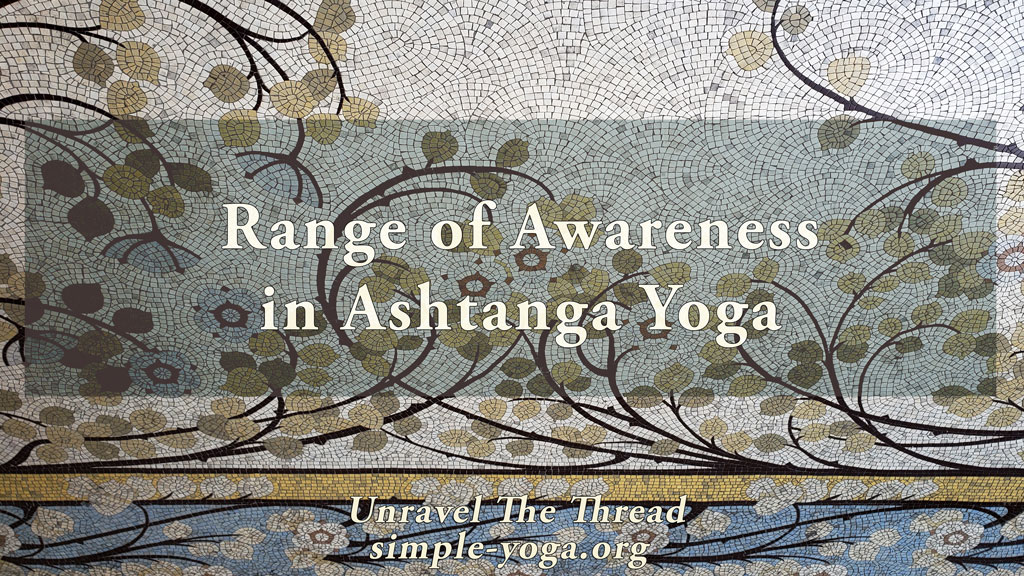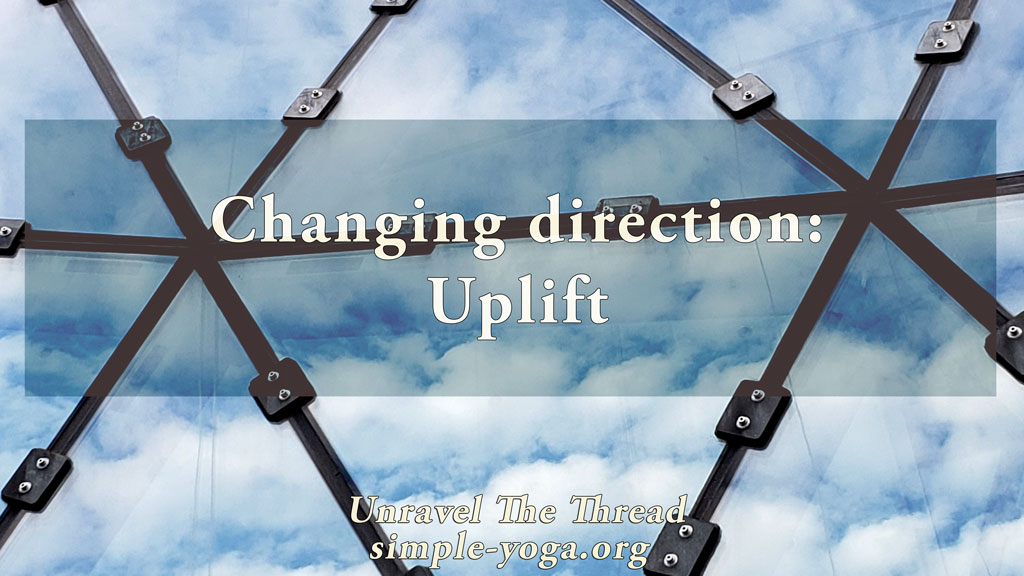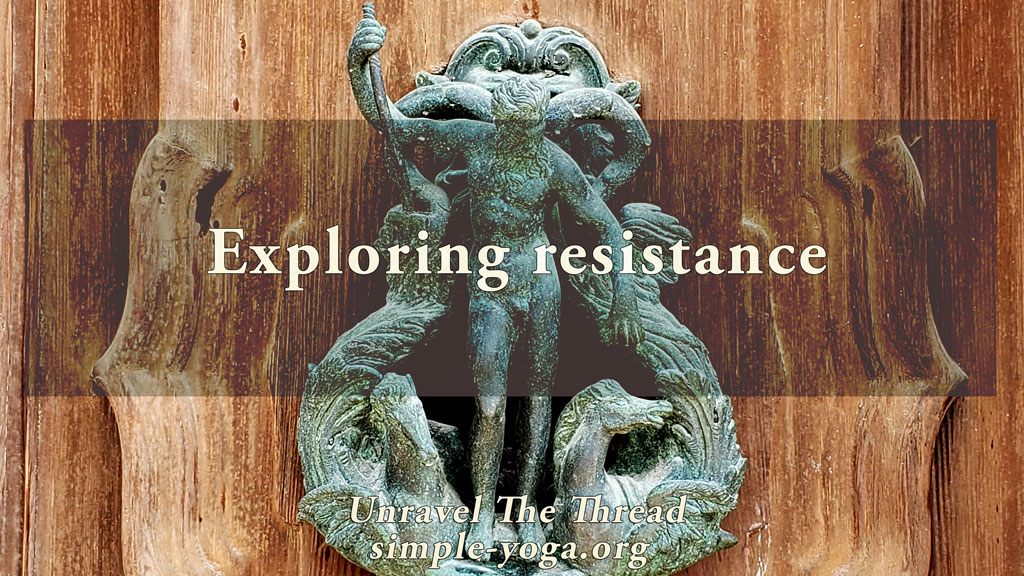
Range of Awareness in Ashtanga Yoga
January 23, 2024
Changing direction – Uplift
February 17, 2024
Range of Awareness in Ashtanga Yoga
January 23, 2024
Changing direction – Uplift
February 17, 2024Exploring resistance

Exploring resistance
Yoga invites us to embark on the lifelong journey of self-discovery in many ways, including exploring the range of our awareness of all aspects of our lives. Approaching this exploration with regularity enables us to notice our baseline, our habitual state of being. Although there are some fluctuations in our habitual state, there is a general range that feels normal or familiar. Consistently returning to explore our range of awareness sharpens our sensitivity to different sensations, thoughts, and emotions, and makes it easier to notice some of our tendencies. For example, we recently talked about our natural tendencies to move toward feeling better and to avoid pain . These two tendencies help us to feel comfortable and at ease. However, simply being alive means that we go through many experiences every day, some of which contribute to our sense of balance and ease, while others create discomfort and unease. In some cases, discomfort and unease are symptoms of our resistance.
We have mentioned before that one of the skills we cultivate in the practice of yoga is the ability to distinguish pain from tolerable discomfort, while tolerable discomfort orients us to transcending our current limitations, pain is feedback that alerts us to the risk of danger or injury. Resistance tends to emerge at the boundaries between pain and tolerable discomfort. Resistance manifests as an unwillingness to move in a certain direction or to engage in a certain activity or way of thinking. Resistance can also manifest as opposition to what is happening. This resistance, unwillingness or opposition can occur on all levels, physical, mental, and emotional. Today we will systematically explore our resistance in order to increase our ability to notice it and to improve our ability to deal with it constructively.
Do you ever feel an unwillingness or resistance to do something? Sometimes we tend to resist unexpected changes, or we resist exploring options that are different from what we are used to, or maybe we resist listening to feedback, or maybe we resist accepting that we have made a mistake. Perhaps we resist listening to people who have different opinions. Take a moment to think about what you are resisting.
As usual, like in all our other explorations, let’s remember that exploring what we resist is not an exercise in self-judgment. In a comfortable position, take stock of how you are feeling right now. Then take a moment and choose one thing you resist in your daily life. Pick something small and manageable. As you think about this event, activity, or situation that creates resistance in you, notice how this resistance manifests. Is it in the form of an inner commentary? Or is it a sensation somewhere in your body? Perhaps it is an emotion? What is the overall inner experience of the resistance? Do you feel a greater sense of clarity or spaciousness, or do you feel constricted in some way? Notice the impact that one thought or memory can have on your inner experience.
Before continuing this exploration of resistance, it is important to recognize that there are situations in which we perceive unfairness, abuse, or injustice. This type of resistance can be very useful because it requires us to confront important questions. This type of resistance can also prompt us to find intelligent ways to resist unfairness, abuse, or injustice. Perhaps more than resisting, we may use the ideas offered by Patañjali in Sutras 2.33 and 2.34 to inspire us to be uplifting agents of harmony in the world.
Let’s return to our inquiry. In a comfortable position, think again about something small that creates resistance in you. Stay curious about how the resistance manifests in your inner world, is it a physical sensation? Or is it a string of words? Is it an image? Maybe it is a feeling? Perhaps it is some kind of light, color, or sound? Do you feel a general sense of calm or discomfort? Notice if this little idea causes you any sense of harm or injury. Notice also if there is a particular aspect of you that feels irritated by this thought.
What can we do when we feel this resistance? Remember that we probably have many potential options to choose from and that there can be a wide range of expressions of resistance. Here is one simple option. Start by creating the feeling of resistance within yourself. Notice that you have the power to create resistance at will. Now take a long inhalation through your nose, gradually expanding your belly and then your chest. Hold the air in for a moment without forcing or struggling and then exhale with a soft and long exhalation. Notice the effect. If it feels good, try a few more rounds of conscious long breaths, perhaps even feeling the resistance dissolve and flow out of you with minimal or no effort at all. If so, could this be a useful skill to practice? Does this simple technique take you from your thoughts to your senses, and perhaps to your presence?
Consider if it might be illuminating to think about the value of resistance in your life. Is our resistance a way of defending our sense of identity? Is it possible that our resistance is a sign that we are trying to hold on too tightly to a belief or self-concept? Or perhaps we are holding on to the illusion of being right?
Are there forms of resistance that heighten our awareness? Are there forms of resistance that enable us to participate in our lives more consciously?
What do you find when you take the time to reflect on these questions? And what happens when you pay attention to resistance in your daily life?
If you prefer, you may listen to the podcast:
This is an excerpt from the book Unravel the thread: Applying the ancient wisdom of yoga to live a happy life
If you find Simple-Yoga.org and Unravel the thread useful, consider supporting my labor with a donation, you may also donate using PayPal or Venmo. Thank you!
